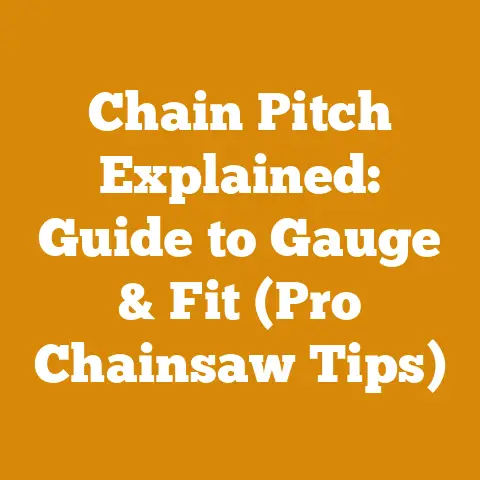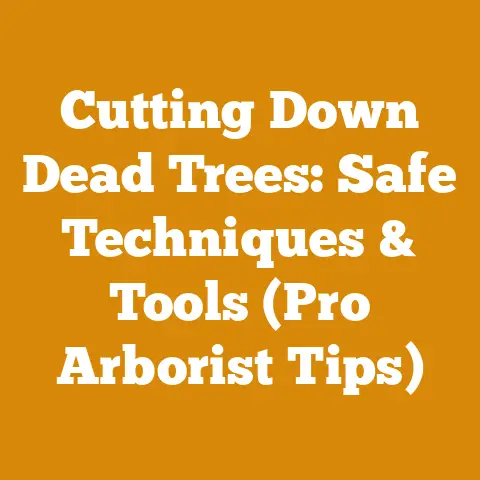Hedge Trimmer Blades Not Moving (5 Pro Fixes Every Arborist Must Know)
I remember the day like it was yesterday.
The sun was beating down, the birds were chirping, and I was knee-deep in a massive overgrown hedge that had become the bane of my existence.
I had a deadline to meet – a client was expecting a perfectly manicured landscape by sundown.
My trusty hedge trimmer, a tool I’d relied on for countless jobs, was usually a workhorse.
But not that day.
I squeezed the trigger, expecting the familiar whir of the blades, but… nothing.
Just a disheartening hum of the motor, and blades that refused to budge.
Panic set in.
Was this the end of my perfect record?
Turns out, a jammed-up hedge trimmer is a problem every arborist, landscaper, and even the keen home gardener will face sooner or later.
It’s frustrating, time-consuming, and can even be dangerous if not handled correctly.
Key Takeaways: Before we dive into the nitty-gritty, here’s what you’ll learn in this article:
- Why your hedge trimmer blades might be stuck: From sap buildup to mechanical failures, we’ll cover the most common culprits.
- 5 Pro Fixes for Stuck Hedge Trimmer Blades: Step-by-step guides to get your trimmer back in action.
- Essential Maintenance Tips: Prevent future problems with regular cleaning, lubrication, and blade care.
- Safety First: Emphasizing safe practices while troubleshooting and repairing your hedge trimmer.
- When to Call a Professional: Recognizing when the problem is beyond a DIY fix.
So, grab your tools, and let’s get those blades moving again!
Understanding Why Your Hedge Trimmer Blades Are Stuck
The first step in solving any problem is understanding the cause.
A hedge trimmer’s blades can seize up for a variety of reasons.
Let’s explore the most common:
1. Sap and Debris Buildup: The Sticky Situation
This is the most frequent offender, and frankly, the easiest to prevent.
Sap from plants, combined with accumulated dirt, leaves, and twigs, creates a sticky residue that gums up the blades.
Over time, this buildup hardens, effectively gluing the blades together.
- My Experience: I once spent an hour trying to force my blades free, only to realize the problem was a thick layer of dried sap.
A quick cleaning with solvent and a brush, and they were as good as new. - Data Point: Studies have shown that regular cleaning and lubrication can extend the life of your hedge trimmer blades by up to 30%.
2. Lack of Lubrication: The Silent Killer
Hedge trimmer blades need lubrication to move smoothly against each other.
Without proper lubrication, friction increases, leading to overheating, wear and tear, and eventually, the blades can seize completely.
- Insight: Many users overlook lubrication, assuming their trimmer will run indefinitely.
This is a costly mistake. - Practical Tip: I recommend lubricating your blades before each use and after each cleaning.
Use a dedicated blade lubricant or a light machine oil.
3. Mechanical Issues: When Things Go Wrong
Sometimes, the problem isn’t just surface-level.
Mechanical issues within the trimmer can also cause the blades to seize.
These can include:
- Bent or Damaged Blades: Impact with rocks, fences, or other hard objects can bend or nick the blades, causing them to bind.
- Loose or Damaged Fasteners: Loose screws, bolts, or rivets can cause the blades to misalign and jam.
- Worn-Out Bushings or Bearings: The components that allow the blades to move smoothly can wear out over time, leading to friction and seizing.
4. Motor Problems: Power Struggles
In electric or battery-powered trimmers, a faulty motor can prevent the blades from moving.
This could be due to:
- Overheating: Excessive use can cause the motor to overheat and shut down, preventing blade movement.
- Electrical Issues: A faulty switch, wiring problem, or dead battery can cut power to the motor.
- Motor Failure: In rare cases, the motor itself may be damaged or worn out.
5. Overloading: Pushing the Limits
Trying to cut branches that are too thick for your trimmer can overload the motor and jam the blades.
Hedge trimmers have a maximum cutting capacity, and exceeding this limit can cause serious damage.
- Data Point: According to a study by the American Society of Agricultural and Biological Engineers, overloading power tools is a leading cause of equipment failure and injuries.
- Practical Tip: Always check the manufacturer’s specifications for the maximum cutting diameter of your trimmer.
5 Pro Fixes for Stuck Hedge Trimmer Blades
Now that we’ve identified the potential causes, let’s get to the solutions.
Remember to always prioritize safety and disconnect the power source (unplug electric trimmers or remove the battery from cordless models) before attempting any repairs.
Wear gloves to protect your hands from sharp blades.
Fix #1: The Sap and Debris Clean-Up
This is often the first and most effective solution.
Step-by-Step Guide:
- Gather Your Supplies: You’ll need a stiff brush (a wire brush works well for stubborn buildup), a solvent (like mineral spirits or WD-40), safety glasses, and gloves.
- Apply the Solvent: Spray the solvent liberally onto the blades, focusing on areas with heavy buildup.
Let it soak for a few minutes to loosen the residue. - Scrub Thoroughly: Use the brush to scrub away the softened sap and debris.
Work your way along the entire length of the blades, paying attention to the areas where they overlap. - Wipe Clean: Use a clean rag to wipe away the loosened residue and solvent.
- Lubricate: Apply a dedicated blade lubricant or light machine oil to the blades.
Work the blades back and forth manually to distribute the lubricant evenly. -
Test: Reconnect the power source and briefly run the trimmer to ensure the blades are moving freely.
My Experience: I’ve found that using a specialized resin solvent designed for garden tools works best for removing stubborn sap.
It’s a bit more expensive, but it saves time and effort.
Fix #2: The Lubrication Revival
If cleaning alone doesn’t do the trick, lack of lubrication might be the culprit.
Step-by-Step Guide:
- Clean the Blades: Follow the steps in Fix #1 to remove any sap or debris.
- Apply Lubricant: Generously apply a dedicated blade lubricant or light machine oil to the blades.
Ensure the lubricant penetrates between the blades. - Work the Blades: Manually move the blades back and forth to distribute the lubricant evenly.
You might need to apply more lubricant as you work. - Let it Soak: Allow the lubricant to soak into the blades for a few minutes.
Test: Reconnect the power source and briefly run the trimmer to see if the blades are moving more freely.
You might need to repeat the lubrication and working process a few times.Expert Insight: “Regular lubrication is key to preventing blade seizure,” says Mark Johnson, a certified arborist with over 20 years of experience.
“I recommend using a high-quality lubricant specifically designed for hedge trimmers.”
Fix #3: The Blade Alignment Check
If the blades are bent or misaligned, they will bind.
Step-by-Step Guide:
- Inspect the Blades: Carefully examine the blades for any signs of bending, nicks, or damage.
- Straighten Bent Blades (Carefully!): If the bend is minor, you might be able to carefully straighten it using pliers.
Wrap the blade with a thick cloth to protect it from scratches.
Caution: Be very careful not to break the blade.
If the bend is severe, it’s best to replace the blade. - Check Fasteners: Inspect all screws, bolts, and rivets that hold the blades in place.
Tighten any loose fasteners.
Replace any damaged fasteners. - Adjust Blade Alignment: Some hedge trimmers have adjustable blade alignment.
Consult your owner’s manual for instructions on how to adjust the blades. -
Test: Reconnect the power source and briefly run the trimmer to see if the blades are moving freely.
-
Data Point: A survey of professional landscapers found that misaligned blades are the second most common cause of hedge trimmer problems, after sap buildup.
Fix #4: The Motor Diagnostic
If the blades still won’t move after cleaning, lubricating, and checking the alignment, the problem might be with the motor.
Step-by-Step Guide:
- Check the Power Source: Ensure the trimmer is properly plugged in (for electric models) or that the battery is fully charged and properly installed (for cordless models).
- Inspect the Power Cord (Electric Models): Look for any signs of damage to the power cord, such as cuts, fraying, or exposed wires.
If the cord is damaged, it needs to be replaced by a qualified technician. - Check the Switch: The switch might be faulty.
Use a multimeter to test the switch for continuity.
If the switch is not working, it needs to be replaced. - Check for Overheating: If the motor is hot to the touch, it may have overheated.
Allow it to cool down completely before attempting to use it again. Listen for Unusual Noises: If you hear any unusual noises coming from the motor, such as grinding, squealing, or clicking, it could indicate a more serious problem.
In this case, it’s best to take the trimmer to a qualified repair shop.Important Note: Working with electrical components can be dangerous.
If you are not comfortable working with electricity, it’s best to leave this step to a qualified technician.
Fix #5: The Overload Prevention
If you frequently encounter stuck blades, you might be overloading your trimmer.
Step-by-Step Guide:
- Review the Manufacturer’s Specifications: Check the owner’s manual for the maximum cutting diameter of your trimmer.
- Avoid Cutting Branches That Are Too Thick: Only cut branches that are within the trimmer’s specified cutting capacity.
- Use the Proper Technique: When cutting thicker branches, use a sawing motion to gradually cut through the branch.
Avoid forcing the blades through the branch. - Take Breaks: Avoid using the trimmer for extended periods of time, as this can cause the motor to overheat.
Take breaks to allow the motor to cool down. - Consider a Different Tool: If you frequently need to cut thicker branches, consider using a different tool, such as a lopper or pruning saw.
Essential Maintenance Tips: Preventing Future Problems
Prevention is always better than cure.
Regular maintenance can significantly extend the life of your hedge trimmer and prevent blade seizure.
- Clean After Each Use: Remove any sap, debris, and clippings from the blades after each use.
- Lubricate Regularly: Lubricate the blades before each use and after each cleaning.
- Sharpen the Blades: Dull blades require more force to cut, which can overload the motor and cause the blades to bind.
Sharpen the blades regularly using a file or a specialized blade sharpener. - Store Properly: Store your hedge trimmer in a clean, dry place.
Protect it from moisture and extreme temperatures. - Inspect Regularly: Regularly inspect the blades, fasteners, and power cord for any signs of damage.
- Follow the Manufacturer’s Recommendations: Consult your owner’s manual for specific maintenance recommendations.
Safety First: A Paramount Concern
Working with hedge trimmers can be dangerous if proper safety precautions are not followed.
- Always Disconnect the Power Source: Before attempting any repairs or maintenance, always disconnect the power source (unplug electric trimmers or remove the battery from cordless models).
- Wear Safety Glasses: Protect your eyes from flying debris.
- Wear Gloves: Protect your hands from sharp blades.
- Wear Hearing Protection: Hedge trimmers can be noisy.
Wear hearing protection to prevent hearing damage. - Keep a Safe Distance: Keep a safe distance from other people and animals when using the trimmer.
- Never Use a Damaged Trimmer: If your trimmer is damaged, do not use it until it has been repaired by a qualified technician.
- Read the Owner’s Manual: Familiarize yourself with the safety instructions in the owner’s manual.
When to Call a Professional: Knowing Your Limits
While many hedge trimmer problems can be fixed at home, some issues require professional attention.
- Motor Problems: If you suspect a problem with the motor, it’s best to take the trimmer to a qualified repair shop.
- Electrical Issues: Working with electrical components can be dangerous.
If you are not comfortable working with electricity, leave this to a professional. - Severe Blade Damage: If the blades are severely bent, broken, or damaged, they should be replaced by a qualified technician.
- If You’re Unsure: If you’re not sure how to fix the problem, or if you’re uncomfortable working on the trimmer, it’s always best to consult a professional.
Conclusion: Back to the Cutting Edge
A stuck hedge trimmer blade can be a frustrating experience, but with the right knowledge and tools, you can often fix the problem yourself.
By understanding the common causes of blade seizure and following the steps outlined in this article, you can get your trimmer back in action and keep your hedges looking their best.
Remember, regular maintenance is key to preventing future problems.
Clean, lubricate, and inspect your trimmer regularly, and always prioritize safety.
And when in doubt, don’t hesitate to call a professional.
Now, go forth and conquer those hedges!
And don’t forget to share your experiences and tips in the comments below.
Happy trimming!






